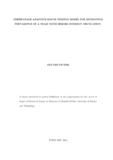THREE-STAGE ADAPTIVE BATCH TESTING MODEL FOR ESTIMATING PREVALENCE OF A TRAIT WITH ERRORS WITHOUT TRUNCATION
Abstract
Batch testing is a fundamental testing scheme that results into substantial saving in terms of cost and time. It is mainly applicable in cases with large population sizes and low prevalence rates. Studies on Batch testing have shown that Adap- tive Batch testing is more efficient than Non-Adaptive Batch testing particularly as the number of stages increases. Most recent studies on Batch testing have shown that even with truncation in inspection, Adaptive Batch testing remains more efficient. In this study a Three-Stage Adaptive Batch testing Model with errors without Truncation is presented with the view to establishing whether or not it is more efficient than the truncated estimator. Maximum Likelihood Es- timate (MLE) method is used to obtain the estimator and Crammer-Rao Lower Bound method to determine the variance of the estimator. Data is obtained through simulation by the help of R-Software tool .The efficiency of the Estima- tor relative to the Adaptive estimator with truncation was determined with the view to performing a comparative analysis between the two. Model verification is done and the results show that Three stage-Adaptive Batch testing model with errors without truncation is more efficient than truncated estimator in the presence of errors. This study is significant in the sense that it brings forth a new model in the literature of estimation in batch testing, a Model that would find application in various fields such as HIV/AIDS , Blood donation, quality control among others.

